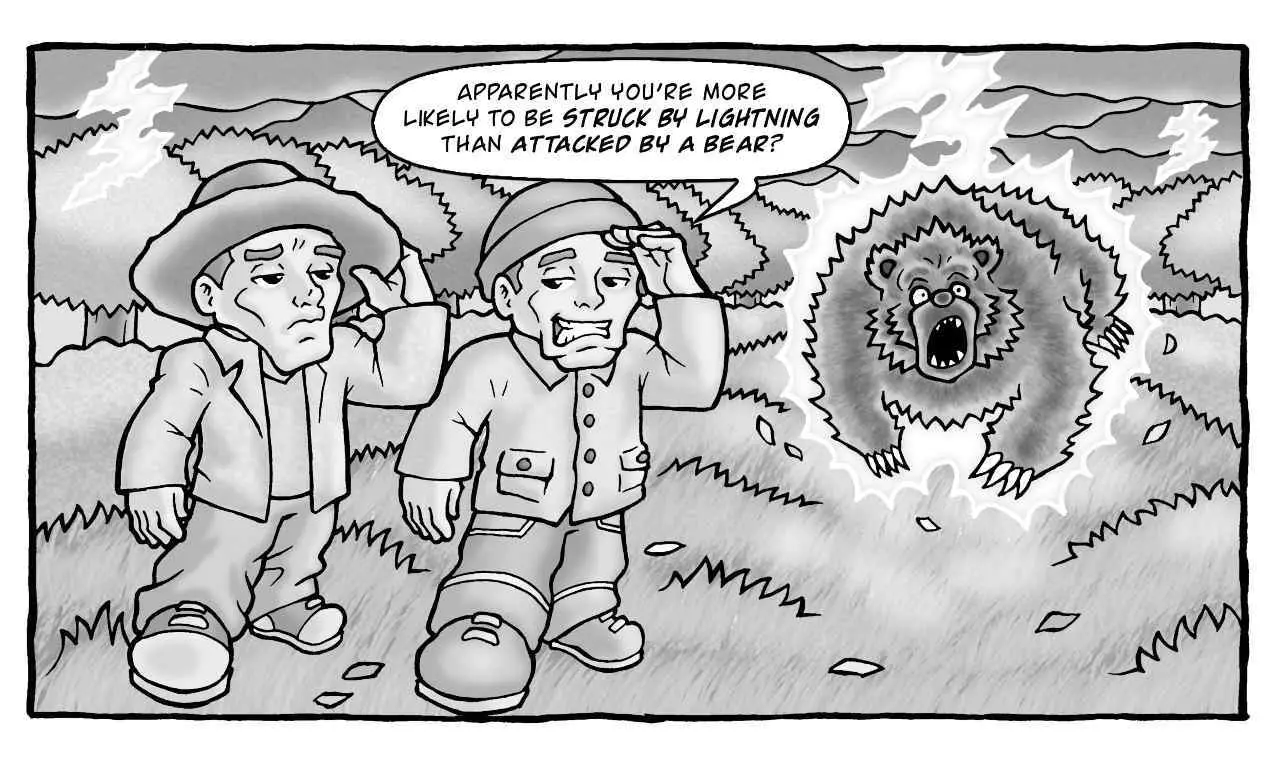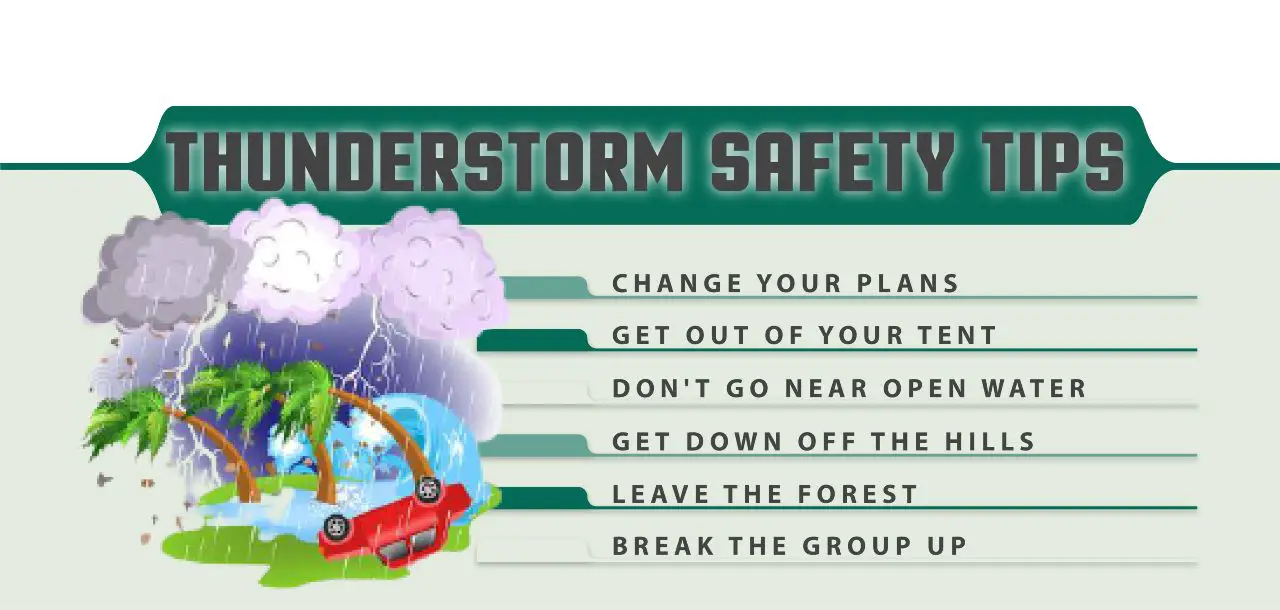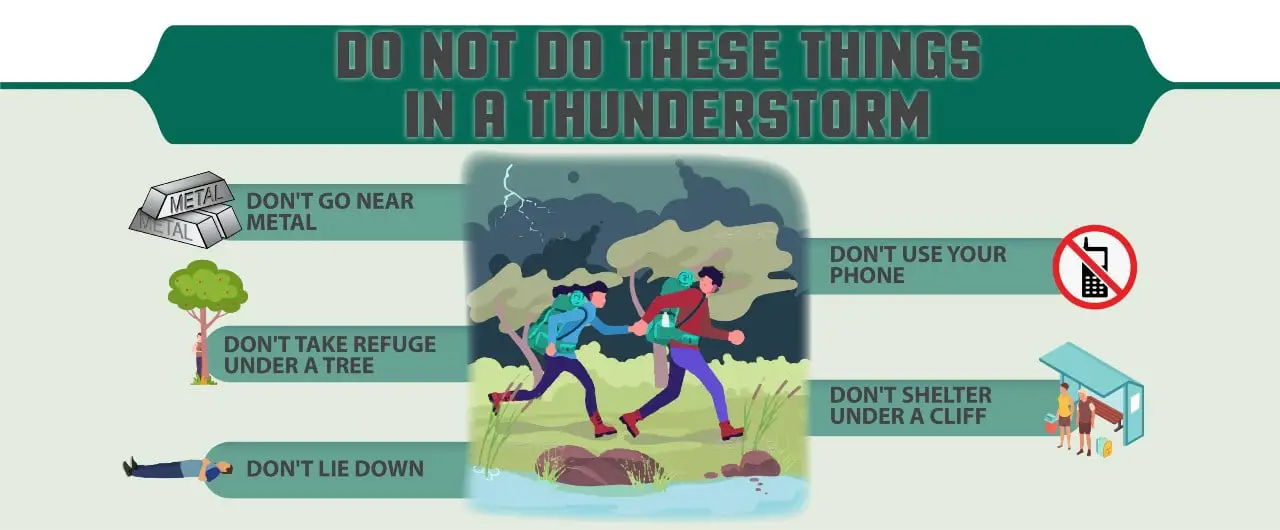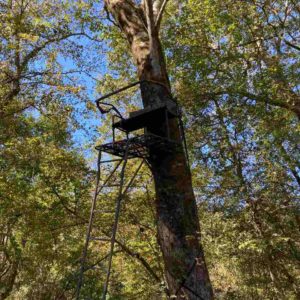A thunderstorm is nature at its most spectacular – and its most dangerous. “Thunder is impressive,” wrote Mark Twain. “But it is lightning that does the work.” Indeed, thunder is merely a bi-product of lightning, whose eye-catching ‘work’ can be every bit as destructive as it is dramatic.
Every year in the US there are about 50 fatalities caused by lightning, which makes lightning more dangerous to the average American than cows (which kill about 20 people a year) or bears (which only kill about 1 person a year).
So if you find yourself outdoors in a thunderstorm, you are in danger.

And even if a lightning strike doesn’t kill you, it can cause terrible injuries. Although 90% of people struck by lightning survive (Source: National Weather Service), many of those suffer severe burns, cardiac arrest and/or long-lasting, debilitating effects, such as memory loss and weakness.
But none of this should put you off going outdoors. Good common sense, good planning and a little bit of knowledge should ensure a lifetime of safe camping and hiking trips.
What to do if you’re caught in a thunderstorm

Change your plans
The best piece of advice is to avoid being outdoors in the first place. If thunder and lightning is forecast, change your plans for your camping or hiking trip, or pack up the tent and head to a hotel. It really isn’t worth the risk to stay outdoors.
Evacuate the tent
If you’re in your tent when the storm strikes, get out. It may seem counter-intuitive to leave the shelter of the canvas but the tent poles could prove a deadly lightning rod.
Avoid open water
Water conducts electricity so if you’re out boating, swimming or fishing, you’re very much at risk. Make it to the shore and head inland as fast as possible.
Get down off the hills
The higher up you are, the greater the risk. That’s why the storm bell-ringers of France once suffered such terrible fatalities. (Hyperlink to last bullet point in ‘Did you know?’). That obviously means getting down from any elevated structures immediately but, also, if you are hiking up in the hills, you should head downhill immediately.
Leave the forest
Forests are safer than sheltering under single trees but they are not an ideal place to be in a thunderstorm. If possible, make your way to somewhere safer. If that’s not possible, avoid being surrounded by any particularly high trees, and keep as far from tree trunks as possible (not easy in a forest!).
Break the group up
If you’re in a group, split up so that all adults are at least 100 metres away from each other. This reduces the overall risk.
Surviving outdoors

Find a safer spot
If you have no option but to see the storm off outside, the best spot to head for is a hollow in the land or a valley floor, away from any trees (particularly single trees), fences, metal posts or anything else that might act as a lightning rod. However, be very aware that, wherever you are outside, you remain vulnerable.
Warning signs
If you can hear thunder, you’re at risk of being struck by lightning. And if the time between seeing lightning and hearing that thunder is less than 20 seconds, the danger is significant.
A particularly serious warning sign to look out for is if you can feel your skin tingling and your hair standing on end. That means that lightning is about to strike.
The crouch position
If you find yourself in this situation, many public health authorities have traditionally recommended taking ‘the crouch’ position to minimise your chances of being struck. This involves crouching down, balancing on the balls of your feet, resting your head on your knees and covering it with your arms. The aim is to touch as little of the ground as possible and make yourself as small a target as you can (Source: BBC). If you have any insulating material, such as a sleeping mat, put it underneath you (Source: Ramblers).
However, other experts argue that the crouch fails to offer a significant level of protection, and has lured people into a false sense of security (Source: The National Weather Service). It may be worth trying as a last resort but by far the best advice is to avoid being outdoors in a thunderstorm at all.
What NOT to do in a thunderstorm

Don’t go near metal
Move away from anything metallic – drop the fishing rod, the tent poles, the camping equipment or the umbrella. If you’re carrying a metal-framed backpack, ditch it until the storm has passed.
Don’t use your phone
Don’t use your mobile phone. Pack it away somewhere safe so that it isn’t exposed.
Don’t take refuge under a lone tree
Sheltering under a lone tree won’t protect you – in fact it’s one of the most dangerous places you can place yourself. And if you see a burnt-out tree that has previously been struck by lightning, never assume that lightning doesn’t strike in the same place twice. It frequently does.
Don’t take risks with an unsecured shelter
Sheds, outhouses and barns are usually not safe places to take cover – and sheltering in caves or beneath cliff edges can be very dangerous.
Don’t lie down
Despite the controversy over the crouch, it’s still much better to get into that position as a last resort than to lie flat on the grass, which simply increases your target area.
Where is safest in a thunderstorm?
There are only two places you really want to be in a thunderstorm – in a building or in a car with a metal roof. And even then, there is a small risk of danger.
Head indoors
The safest place to be in an electrical storm is in a building. It could be a house, an office, a shop or a hotel – but as long it has a proper roof and solid walls, and the windows and doors closed, you are highly unlikely to come to any harm. If buildings such as these aren’t grounded by rods, their plumbing, gutters and other building materials tend to provide the same protection. The same cannot be said of sheltering in a shed, outhouse or barn. And even indoors, there are risks to be aware of.
Shut yourself in a car
If you can’t get inside a secure building, a car is a very good alternative as the metal roof and frame will protect you. However, if the car is struck by lightning, parts of it may be damaged. Also, soft-top convertibles are not safe and may catch fire if hit by lightning. Unless urgently required, don’t drive in a thunder storm, and always keep the windows wound up.
What to do if someone is struck by lighting
- Make an emergency call for medical help.
- Check their pulse and heartbeat. If required, and you have undergone first aid training, begin artificial respiration and CPR.
- If they are breathing comfortably, check for other injuries. They may have serious burns where the electric shock entered and then left their body (the latter is usually through the feet). Other common lightning injuries include broken bones, or a loss of hearing or sight.
And if you make it indoors…
Even indoors, you should take care. Metal can conduct electricity into the building, you may suffer from power surges and, while highly unlikely, lightning may shatter windows.
- Keep doors and windows shut.
- Don’t stand close to the window.
- Don’t use a cabled telephone.
- Don’t use taps and sinks, or take a shower.
- Unplug major electrical appliances, such as TVs, computers and games consoles.
Understanding Lightning?
Lightning is the visible discharge of electricity that occurs when a region of a cloud acquires an excess electrical charge that is sufficient to break down the resistance of air (Source: Britannica.com).
It usually strikes when a negative discharge in clouds causes objects on the ground (such as trees, metal signs, open water and the ground itself) to become positively charged. Nature’s way of correcting this imbalance is to pass a current between the two.
A much smaller percentage of thunderstorms (about 10%) are caused by a positive charge in the clouds. These can be even more powerful and dangerous than negative discharges because they tend to travel from higher up in the cloudbase, gathering ferocity as they head towards Earth (Source: National Weather Service).
Lightning can heat the air around it to temperatures five times hotter than the sun’s surface (Source: National Geographic). This intense heat causes the surrounding air to expand and vibrate, creating the thunder that we hear after the lightning flash. The delay before we hear the thunder is the consequence of the speed of sound being slower than the speed of light).
Types of Lightning
There are several types of lightning but the most common threat comes from cloud-to-ground lightning – there are about 100 of these strikes on the Earth’s surface every second (Source: National Geographic).
The most common forms of lightning are harmless because they don’t leave the clouds. Other rare forms can be triggered by snowstorms, rampant forest fires and volcanic eruptions.
There is also the supposed phenomenon of ‘ball lightning’, in which lightning takes the form of a flaming ball that flies through the air or along the ground. While appearing frequently in literature and folklore, proof of its existence relies more on eye witness reports than firm evidence, and many scientists have written it off as an optical illusion.
The saying that lightning never strikes in the same place twice is untrue. In reality, it often strikes in the same place more than twice.
Did You Know…
Since you’ve read this far, you might enjoy these somewhat random but nevertheless interesting facts about thunder and lightning.
Your eyes deceive you
The flash of lightning that you can see in the sky travels far faster (1,079 million kilometres per hour, the speed of light) than the lightning itself (435,000kph) (While the average length of a lightning bolt is 3-5 kilometres, the actual width is only about 2-3 centimetres (Source: Met Office).
Hector the Convector
Almost every afternoon between September and December, a thunderstorm erupts over the Tiwi Islands off Australia’s north coast. The storms are caused by perfect conditions for convection and can be so spectacular that they are seen 100 miles away in Darwin. Locals have fondly named the spectacle ‘Hector the Convector’ [Source: The Weather Network].
Don’t camp here…
The world’s most dangerous place for thunderstorms is Lake Maracaibo in Venezuela, which experiences storms on 140-160 nights a year, with as many as 40,000 lightning strikes a night (Source: Met Office)
Belgian fireworks
On 17 June 1955, a thunderstorm near Le Pelerin in Belgium struck a pylon that had inadvertently been erected over a German mine left over from World War One. It was a substantial explosion, creating a large crater and killing an unfortunate cow (Source: firstworldwar.com).
Extra-terrestrial thunderclaps
Thunderstorms don’t just happen on Earth. Two extra-terrestrial thunderclaps are believed to have been recorded by a Soviet mission to Venus on 25 December 1978 (Source: Guinness Book of World Records).
The doomed bell-ringers
Until the late 18th century, it was believed that church bells repelled lightning. Many bore the inscription fulgura frango (‘I chase lightning’) and bell-ringers would rush up the church towers when a storm started. However, a high tower with a metal bell is just about the worst place to be in a thunderstorm. Between 1753 and 1786 in France, 103 bell-ringers were killed by lightning, and the practice was ended (Source: Met Office).
It’s Not Fun Being Struck By Lighting
Perhaps a bit of a no-shit-Sherlock moment here! But here’s a story that’s half lovely, half terrifying from Mr & Mrs Romance: That Time We Were Struck By Lightning.






